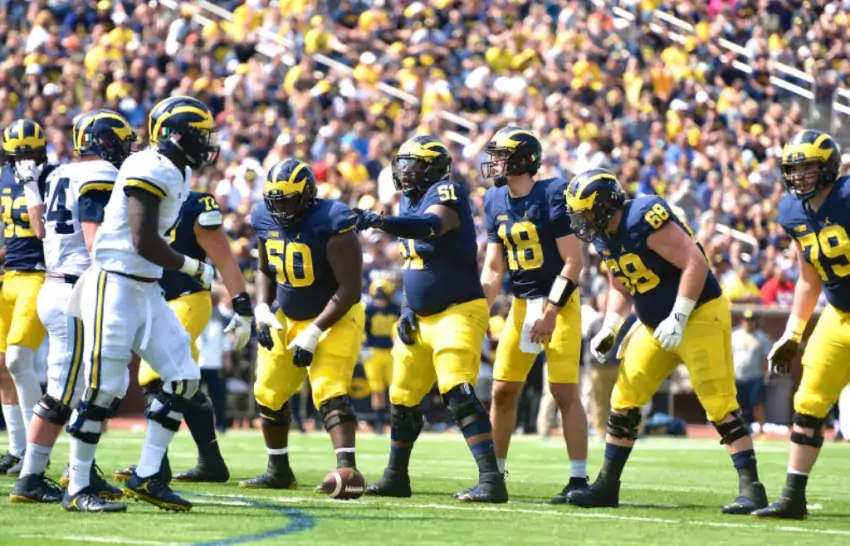
Upon Further Review: The Glossary

Check off one more offseason project. Brian wrote a FAQ in 2009 but we've seen a lot of things since then, and I might do things a little differently, meaning it was due for a massive update. If it's a wonky word used in more than one Upon Further Review, you should be able to search it on this page. Sometimes opponents will have weird strategies or formations that I'll call out in that UFR.
Headers
What do the columns stand for?
- Ln: Line, as in where you are on the football field. O means opponent, M means Michigan. So O25 means the ball is on the opponent's 25.
- Dn: Down.
- Dst: Distance.
- OForm: Offensive formation.
- DForm: Defensive formation (offense only, I get more specific on the Defensive UFRs).
- DPack (defense only): The defensive personnel: [DL-LBs-DBs].
- Front (defense only): The defensive front.
- RB/TE/WR: Number of RBs, TEs, and WRs. A * in the TE field indicates one of them is a fullback.
- Hi: The arrangement of the secondary, starting with how many high safeties (usually 1 or 2, sometimes 1.5) and then the cornerback alignment: "off" (both CBs are giving a cushion), "press" (both CBs or all relevant CBs are down close to the WRs), or if they're mixed I'll note which CB is high, where "fld" is the field corner and "bdy" is the boundary CB.
- Box (offense only): How many defenders are in the box.
- Type: Type of play. Run, Pass, Play-action, RPO (run-pass option), PRO (an RPO that went with the pass option)
- Rush: How many pass rushers the defense brought.
- Play: What play the offense ran. For passing plays it's usually just the route unless we got to see the route combo. On defense I tend to give the player who ran the route (on offense the next column makes this obvious).
- Player: The player targeted. On offense it could be the ballcarrier, the receiver the throw went to, etc. When Michigan's on defense it's the player the offense was trying to beat, e.g. the CB expected to provide coverage on the throw, or in some cases the guy who made the sack.
- Yds: Yards gained/lost/etc. Yards in parenthesis are penalty yards.
- EPA: Expected points added. Calculated by the offense's expected points from the game state before and after this play (after penalties).
General Football Terminology
What's the difference between strongside, weakside, playside, and backside?
Strongside and weakside are pretty self-explanatory: if there's a tight end (or two) in the game or an offset H-back/fullback, the side with more players on it is the strongside and the other side is the weakside.
Here, the strongside is to the top of the screen as that's where Kevin Koger is aligned. Some formations don't have a strong or weak side.
Playside is basically the direction the play is run in, and is important on stretch plays mostly. If the offense is running to the right, the right is the playside and the left is the backside. These terms usually get mentioned in the following ways:
- The "backside" defensive end is the player who doesn't get blocked by the defense and is instead read by the quarterback.
- I'll often refer to a good block by an interior lineman, usually the center, as sealing a guy "lined up playside of him". What this means is that the defender lined up outside of the OL—closer to the area where the running back will attempt to cut the ball up—and still sealed him away.
- Other blocks will be described as an OL "getting playside" or failing to do the same, which basically means the OL gets between the DL and his attempt to flow down the line of scrimmage and tackle as the back cuts up.
=========OFFENSE=========
WHAT IS 11 or 22 PERSONNEL, ETC.?
These are personnel designations. The first digit is the number of RBs on the field, the second the number of TEs, and you can imply the WRs by subtracting 5 from the two digits. For example Gun 12 means shotgun with 1 RB and 2 TEs. If I leave it out it's the assumed personnel for that formation:
- Gun or Pistol: 1 RB, 1TE, 3WR.
- Ace: 1 RB, 2 TE, 2 WR.
- I-form: 1RB, 1FB, 1TE, 2WR.
- Heavy: 1 RB, 1 FB, 2 TE, 1 WR, or 3 TEs but one acting like a FB.
- Goal Line: 1 RB, 1 FB, 3 TE.
- 4-Wide: 1 RB, 4 WR
- 5-Wide: 5 WR
When Michigan goes 4w or 5w it's almost always from 11 personnel, so I don't bother to note it. With opponents I will note it's 11 personnel.
WHICH POSITION DOES THIS LETTER REFER TO?
I try to keep this standardized, and usually will keep it to a designation covered under the role the player is on the roster to play.
LINEMEN: C is center, G is guard, T is tackle, R/L are right and left etc.
TIGHT ENDS AND FULLBACKS: This gets a little messy. In order of primacy:
-
- F. The F-back, in general the second tight end, either the one off the line of scrimmage (if one is on it) or the one on the formation's weak side. Occasionally I'll use "F" for a fullback as well, since TE and FB depth charts get blurry.
- FB. A designated fullback.
- U. Upback or third tight end in 3TE setups.
- S or SB. Superback, usually only used for Northwestern's FB/TE who lines up as a upback.
- W. Wingback, a mostly defunct RB/TE position. Used rarely except in context of historical football.
- 6. A 6th offensive lineman.
I don't use "H-back" for tight ends because H is a slot receiver.
WIDE RECEIVERS: The outside WR on the strongside who can be on or off the LOS (traditionally the flanker) is usually the Z and the one on the backside, almost always on the line of scrimmage (traditionally: split end), is X. A third or slot receiver gets the designation H, and if there are more I call them J and Sl for slot.
RUNNING BACKS: If there's one he'll be "R". If there's a second he's "A" and a third is "B" but we almost never get to that except when talking about triple-option teams.
Offensive Formations
What does "Gun Wk Y Flex Z-Jet" mean? These are all codes to decipher what the offensive formation
Ace:
- A formation with the QB under center and one RB directly behind him, for example I would call this "Ace 11 Trips."

- A formation with TEs deployed to either side of the tackles. This is Pistol Ace.

- Used to write here. Second-best all-time at Draftageddon. Eats lemons on the internet.

Ace-11. A weird formation where the tackles are spread out.
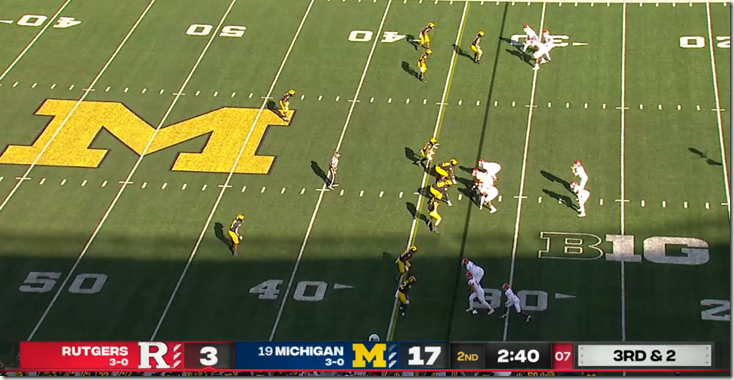
-> Arrow (for example Y->R). When a player is noticeably out of position. For example this is Gun 4w Y->H, meaning they're in a Shotgun 4-wide formation , but the tight end (Erick All) has replaced the slot receiver on the bottom.
Beef. Michigan's Pistol 13 FB Heavy formation with an extra OL in place of one of those TEs. Mostly a goal line thing.

Bone. Short for Flexbone, a specific type of Ace formation with both sides bunched. Triple-option teams like using the Flexbone with running backs on the wings, but heavy running teams like Wisconsin are known to bring it out with a pair of TEs or FBs on the wings because it's an excellent running formation.
Bunch. The wide receivers (and perhaps one TE) are packed together outside. For example this would be Offset Trips Bunch:
Covered. When a usually eligible receiver is on the line of scrimmage with another player on the LOS outside of him. Our covered guy is not an eligible receiver on this play and will be designated as such in the formation with parentheticals. For example I would call this one Gun Trips (X) because the X is covered by the Z receiver.
Flex means the position referenced is "flexed" out instead tight against the line. This is Pistol 12 Y Flex:
Fritz. A diamond formation, so named for Crisler when Michigan used it as the Denard Jet package in 2011.
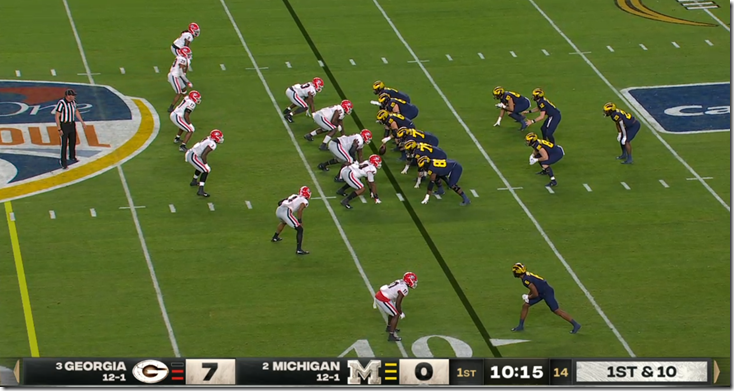
Demi. For demi-flex. When the TE is a little bit flexed out—like 2 yards at most. Demis (plural) means two TEs are aligned as such.
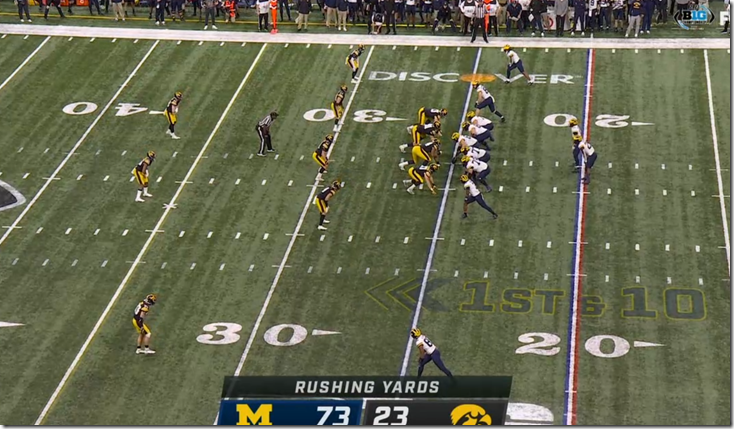
Gun or Shotgun. The quarterback is set up ~4 yards behind the line of scrimmage either alone (Empty) or with a RB by his side.
Heavy. Another word for 13 personnel, IE one back and three tight ends/fullbacks.
Offset. Cross between Gun and Pistol. The QB is set up at Pistol/Shotgun depth with the RB behind and to his side.
Pistol. Shotgun formation with a running back stacked directly behind the quarterback.

Quads. Four wide on the same side of the formation.
RB. Means the RB is flipped opposite the strength of the formation. Sometimes I also use "/R" for the same thing. This is "Gun Str RB" or "Gun Str /R":
Stack. The wide receivers (and perhaps one TE) are stacked, i.e. one behind another, outside. If plural that means it's happening on both sides.
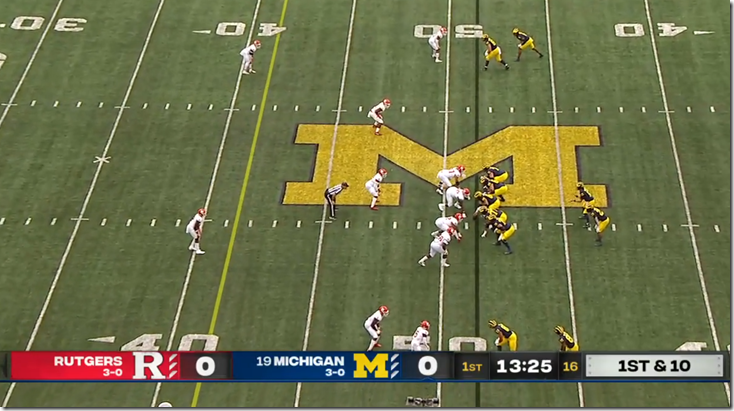
Str. As in "Gun Str" means it's a three-wide formation with the slot receiver (H) lined up on the strong side of the formation.
Tackle Over. An unbalanced formation once favored by Brady Hoke with both tackles on the same side of the formation. Note the TE (Y) is uncovered and thus an eligible receiver.
Tight. Wide receiver pulled in close to the formation, like tight ends. This is Gun Wk Z Tight:
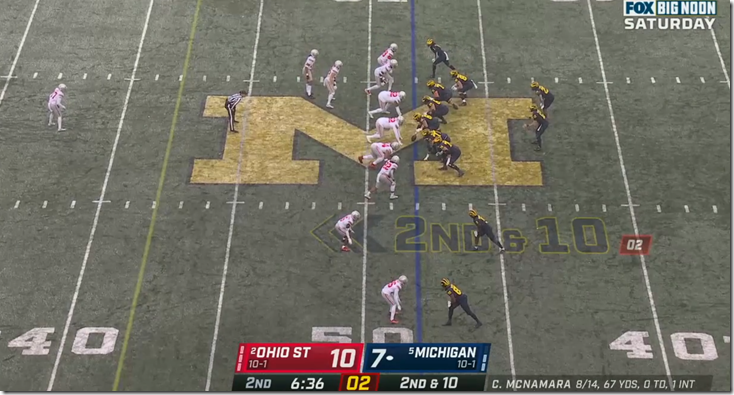
TO. See Tackle Over.
Trips. A formation with three receivers to one side. Also known as 3x1. If there are two wide receivers to the TE's side I call it "Str" instead.
TTB. Trips Tight Bunch.
TTE. Trips Tight End. Previously referred to as Gun Ace Twins which was a mouthful.
Twins. A formation with two WRs on the field, and either two TEs or a TE and an extra RB on the other. Unless it's specified that two RBs are on the field (e.g. Gun 21 Twins) the basal "Twins" setup has a pair of tight ends opposite the receivers.
Unbalanced or "Unbal" for short. A trick formation that puts more OL to one since of the center without covering a receiver, often by flipping a tight end with a tackle.
Wk for "Weak." My designation for a 3-wide formation with the 3rd (slot) receiver, or H, lined up on the weak side of the formation.
(Y) or Parentheticals in the Formation. See Covered.
- Hyphen after a position letter, as in "Y-In" or "Z-Jet" signifies that player is in that kind of motion. For example "Gun Wk Z-Orbit" means the Z went in an orbit motion. See Motions.
/ (Slash) before a position letter, as in /R. The player is lined up on the opposite side you would expect him to be, e.g. the RB is aligned on the same side as both the F and TE.
2RB (or split). In an offensive formation context it's two RBs to either side of the QB. I use "2RB" because "Split" for "Splitbacks" gets used so much in the defensive formations.
2TE or 3TE. Means two (or more) tight ends aligned on the same side of the formation without moving the receivers from their natural positions. If both receivers are on the same side from this look we call it Twins.
2x2, 2x3, 3x2, 3x1, 4x1, 4w or 5w. Four or five wide, but now I designate it by # of targets to either side of the QB, starting with the field side. It doesn't necessarily mean receivers; I will note the personnel separately. For example this is Empty 3x2 from 122 personnel.
Receiver Routes
A non-comprehensive list:
- Angle: RB route where he turns sharply inside after heading to the flat, effectively turning into a slant.
- Circle: route with an inside feint on which the receiver comes to a stop and then breaks to an out. This usually results in something of a circular path. Michigan won the 2009 Notre Dame game with one.
- Comeback: The receiver was running downfield then came back to find space after the blocking broke down.
- Corner: A post that breaks to the outside, usually run by slots or tight ends.
- Curl: or "hook"—some coaches use one or the other to mean a turn in versus out. Usually a TE or slot receiver, takes three-ish steps upfield then turns around for a quick underneath throw.
- Dig: Like an "In" route but run deeper, and the goal is to get him moving horizontally, not just hit him inside on the cut. Traditionally differentiated from a "Square In" in that a dig route starts with a slant before turning up and in, but we don't make this distinction.
- Drag: or "drive." TE or slot receiver drags across the field maybe a yard to three downfield. Usually a checkdown that comes open late if it does at all.
- Dumpoff: When the QB just wants to get rid of it and tosses it to a player sitting under the coverage who then tries to gain the yards with his legs. Different from a leak because the defense is expecting or even encouraging this.
- Fade: A speed route that drifts to the outside, usually run by slots or to tall guys near the end zone, with the intent of the receiver winning a jump ball outside trail coverage.
- Flag: also "deep out." That's what it is, a deep out.
- Flare: also "swing." Running back originally lined up in the backfield runs mostly parallel to the LOS and receives a pass behind said LOS.
- Flat: usually a slot receiver or TE but can also be a fullback or RB. Basically a really short out route that attempts to exploit cover three, which usually doesn't have defenders out there.
- Hitch: A slightly deeper curl route, usually by an outside receiver who acts like he's pushing high then stops and curls in for the pass.
- Fly: also "go": receiver runs as fast as he can straight down the field.
- In: player runs some distance downfield and takes a hard 90 degree cut to the middle of the field.
- Leak or Delay: Player, usually TE or RB, stays in like they're blocking then release and get the ball quickly. Think Erick All on 3rd downs vs Nebraska.
- Mesh: A pair of crossing routes that meet in the middle, aiming to find space between zones or rub off man defenders. (Neck sharpies).
- Option: receiver can choose to go right/left or stop; and and QB are reading his defender to choose.
- Out: player runs some distance downfield and then takes a hard 90 degree cut to the sideline.
- Post: variant of fly where after 10-20 yards, depending on the coverage, the receiver breaks his go route to the inside at a 30-45 degree angle.
- Seam: basically a fly route run by an interior receiver. Called a seam because usually there are deep middle safeties and the quarterback has to find the seam in the zone between the linebackers and said safeties.
- Skinny Post: A cross between a seam and a post.
- Slant: Outside WR runs diagonally up the field into an area that should be good against either man or zone coverage. Usually a short route good for 6-8 yards.
- Sluggo: Slant and go.
- Smash: Combination route where the inside receiver runs a corner route and the outside receiver runs a short hook underneath him.
- Snag: A route run by an outside WR who sits down underneath while a guy inside of him pushes upfield and a guy behind him stretches the flat.
- Stop: An outside route that looks like a fly until the receiver cuts it off underneath the bailing DB.
- Wheel. Running back or tight end hauls ass out of the backfield, running what looks at first like a flare route before turning it up as he nears the sideline to attack areas a wide receiver has already dragged through to clear out a zone.
- Zip or Whip or Zig: Starts like a slant in then the receiver takes a sharp turn outside.
- Zag: Zip flipped: starts as a flat route then comes inside.
Motions
Pre-snap motions. If you see a hyphen then I am attaching the motion to that player, for example "H-Jet" means the slot receiver is coming in Jet motion. I only call out motions within 1 second of the snap. Since coaches have all sorts of words I use terminology from Viqtory Sports just to keep it simple. They are:
- Cross. When a TE slides from one side of the formation to the other. Note VS calls this "Over."
- Flare/Exit. When the RB leaves the backfield to his own side (opposite would be Orbit or Fly).
- Flex. Moving from inside the formation to the slot, e.g. if a TE shifts to the slot.
- Fly. Jet motion except the ball is snapped after the player has crossed to the other side of the formation.
- Glide. Motion from way outside to still-outside, e.g. if the Z is going to slant inside the H.
- In. A move from outside alignment inside, or for a TE from the wing inside. Does not cross the QB.
- Jet. The player starts wide and comes in where he'll be in position to take a handoff in front of the QB. A Jet motion that is completed to the other side of the formation is a Fly motion, and if he comes back it's a Return. Note: if it's the slot receiver I often just say "Jet" because it's assumed he's the one in motion.
- Orbit. A type of motion where the back or receiver crosses the formation behind the QB.
- Return. There and back again, basically. A player shifts across the formation, then back across the formation again, for example if the Flex TE shifts from left to the right wing, then back to the left wing.
- Slide. When a player, usually the RB, comes down toward the LOS then motions outside and the ball is snapped while he still has momentum.
- Wide. Moving from inside or flex to outside, e.g. if the RB splits out to the Z position.
Screens
Quarterbacks do not get credit for screens in UFR unless they involve some throwing difficulty. The types:
- Bubble. Slot receiver runs parallel to the line of scrimmage in an effort to get behind the block of the outside receiver and spring downfield for 6-10 yards.
- Double. A slip screen combined with another screen on the other side of the formation, with the QB choosing which to throw.
- Flare. Similar to a bubble but it's the RB running a flare route while the outside WRs block for him.
- Flash. Target runs downfield then back upfield of the linemen heading out to block for him.
- Slip. Name for the standard RB screen where he slips out of the backfield as the DL pass rush too far upfield.
- Smoke. A quick screen thrown to a WR under soft coverage. Amara Darboh was great at these.
- Split Flow or TE or Flat. Variants of having the TE run just behind the line of scrimmage while a WR cracks the guy tailing him. Note: catch must be behind the LOS or it's pass interference.
- Throwback. Or waggle screen--QB rolls out one direction then throws back to a player who went to other way with a couple of blockers. Think Vincent Smith's TD in UTL1.
- Tunnel. Similar to a Flash Screen except the target is coming inside the flaring OL, who are trying to get kickouts.
Block Types
Often I don't specify but when I do:
- Double. When two blockers work on one defender.
- Combo. Any block where two blockers work a defender so that only one can take over.
- Kickout. Blocker attempts to shove an edge defender wide, creating space inside him.
- Reach. Blocking a defender who lined up at least a gap playside. This is hard and usually results in a big run.
- Stalk. Usually a WR on CB block, where the blocker is mostly just running with the defender to prevent engagement.
- Trap. A surprise blindsiding on a defender allowed upfield.
- Wham. A vertical trap block most often accomplished by a fullback on a DL charging upfield confused why the OL didn't block him.
Offensive Plays
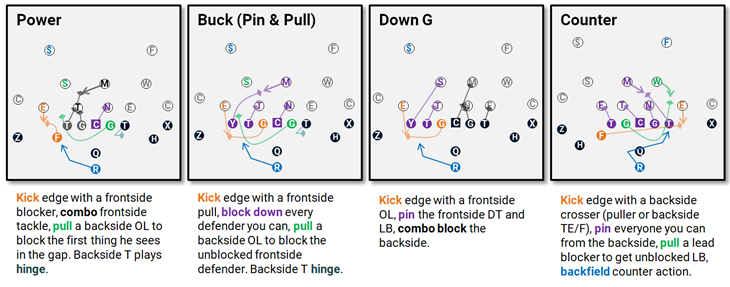
3-O. Triple-option.
Arc. The zone read that looks like split zone except if the QB pulls he and the crosser (usually a TE) whoop around the edge defender they read.
Bash. An inversion of the zone read where the RB is going outside and the QB would have the dive. Also called Inverted Veer.
Belly. A version of a standard inside zone except the backside DT is doubled out of the way so the RB can run straight downhill behind that.
Buck (or "pin & pull"). A power running play where two pulling linemen go around one or more down-blocker(s), the first kicking out the unblocked edge defender and the second lead-blocking through the gap. Standard Pin & Pull is the both guards pulling but it can be a lot of different combinations. If it's not the guards I'll note which players are pulling, in order, for example Buck CG (see below) would mean the center and backside guard are the pullers. We called this play "Pin & Pull" for years but "Buck" means exactly the same thing. Subject of a What Is.
Counter usually refers to Counter Trey and its variants, a type of gap or power run which, like Buck, has multiple pullers, except they're coming from the backside. Often I'll specify who's pulling with the letters of the two pullers, first puller first, e.g. Counter GT. No letters means it was the backside guard and the backside TE.Down G or G or T is a power on the frontside, zone backside. There's one puller from the frontside kicking out.
Dart is power with a tackle pulling. Also called Power T.
Dive is a run right down the middle.
Double Stretch or Jet Stretch is a stretch zone where parts of the line block in different directions, often paired with a Jet or Bash threat to the side opposite the main blocking.
Duo is inside zone except the double-teams on the DTs continue while the RB looks to try to get the unblocked LB to go in the wrong gap.
Flea Flicker is a trick pass play where the QB hands off to the RB who then stops and flips it back to the QB to pass.
Fold. A two-man combo where the playside guy blocks down and the guy next to him has a short pull around him.
Inside Zone is the standard zone run where the OL combo through the DTs to the LB level.
Inverted Veer. A zone read that reverses the jobs of the QB (run downhill) and RB (veers outside)
Iso is short for Isolation, a quick-hitting (this is key) downhill run where the RB has one or more (double iso) lead blocker(s) (usually a FB) to run behind, cutting off the open side of the block.
Mesh is the popular play where two crossing routes pass each other, rubbing off the trailing man coverage or finding spots to sit in zone. Rail is a popular version of Mesh with the RB flaring out as the 1st read and a mid-range route above the mesh.
Pin & Pull or Pin and Pull or Pin 'n Pull. See Buck.
Power. A gap-blocked play where you pull a backside player, usually a guard, to lead. God's play.
Power Read. Power version of Inverted Veer: QB is the dive option, RB is the edge option, with power blocking.
Split flow is a constraint play off of split zone where the crosser (usually a TE) then goes out in a pattern while the QB reads the flat defender and decides to throw to the TE or hand off on the dive.
Split zone is a common zone run with a player coming across the formation from the playside to kick out the backside.
Stretch is Stretch Zone or Outside Zone the style of blocking where the OL is moving sideways to outflank the DL.
Tight zone is inside zone except the point is to shove everyone forward, not climb to the next level. Usually a goal line or short yardage play. Different from Duo because there's no attempt to fool the MLB...just run through him.
Trap is a type of block where an interior defender (usually a DT) is allowed upfield then hit sideways, by a puller as they run inside that. If the kickout occurs outside the tackles it's a Split not a Trap.
Wham is a type of block where a backfield player (usually a FB) blocks a DT, who's allowed upfield.
ZR. Zone Read. The Rich Rod play where they read a backside DE.
=========DEFENSE=========
COMMON Defensive Terms
Box. The area between the tight ends and stretching 6.5 yards past the line of scrimmage. The number of defenders in the box corresponds to defensive aggressiveness against the run. I don't count CBs, so this is an 8-man box:
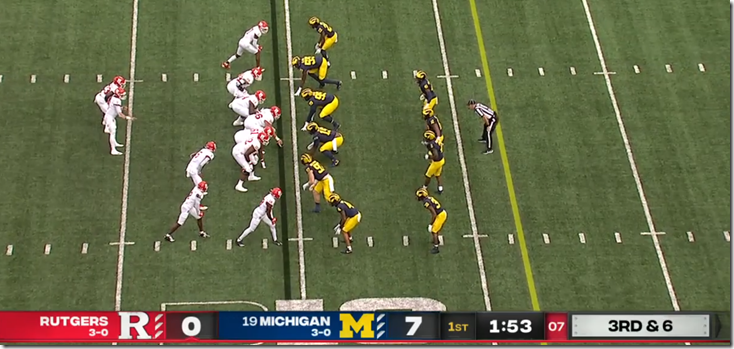
Cover X. The number describes how many players are playing in a deep zone. Generally the higher the number the more conservative.
DPack. The numbers of linemen, linebackers, and defensive backs on the field expressed in three digits. Often we leave out the DBs, e.g. "3-4" instead of "3-4-4."
Funnel. Common defensive tactic for 2 defenders vs a blocker and a ballcarrier, where the first defender will attack the blocker's shoulder opposite the free defender, thus funneling the ballcarrier to his buddy.
Pattern-Matching. A version of Cover 3 where the defenders can switch to man coverage based on what routes the offense is running.
Quarters. A version of Cover 4 where those defenders can switch zones depending on what routes the offense is running. Dantonio's defense was Quarters.
Nickel. A formation where a linebacker's been removed for an extra defensive back. It's 4 DL, 2 LB, 5 DB unless noted otherwise. If the defense uses an all-downs hybrid linebacker we usually call that a 4-2-5, or a 4-3 if he's particularly linebackery.
Spill. When a frontline defender, e.g. a DE, dives into an inside gap in order to force the ballcarrier to bounce around outside, trusting the next defender (usually a LB) will replace the spiller on the edge.
Tech. The "Technique" is the spot relative to the offensive players that a defensive player is centering his mass when aligning. As with all good indexing systems, it starts with zero, which is head-up over the center, and increases the farther you get away from the center. Helpful diagram:
Single-digit numbers refer to linemen, e.g. the 3-tech is a lineman off the guard's outer shoulder. Double-digit numbers are linebackers, e.g. the 10-tech is a linebacker off the center's shoulder.
POSITIONS AND LETTERS
- A: Anchor. The SDE in Don Brown's defense.
- C: Or CB. Cornerback.
- E: End. Used for the WDE or both DEs.
- F: Or FS: Free safety.
- J: Jack. What some teams call their standup OLB/DE.
- M: Or MLB or MIKE. Their middle linebacker, or strongside ILB if there are two.
- N: Nose.
- Nk: Or ☆. Nickel or hybrid space player.
- O: Or OLB for Outside Linebacker.
- SDE: Strongside defensive end. Usually heavier than a WDE.
- $: Strongside safety or the "Money" safety who plays down over slot receivers more often.
- T: Tackle. DT that's not the nose.
- V: Viper. The hybrid S/LB in Don Brown's defense.
- W: Or WLB or WILL. The weakside linebacker. Usually the designation for the 2nd inside linebacker.
Defensive Formations
30 or 40
Usually I'm referring to the type of front: a four-man line (40) or three-man line (30), as in "Michigan's 30 fronts are getting killed."
Fronts
A or B or C or D after the formation means there's a LB standing at DL depth in that gap. The example below would be AAD (LBs in both A gaps and one in the D gap). The next image below, for example, would be a "Nk Eagle AA" because both LBs are down in the A gaps.
Eagle. Big splits between the DTs.
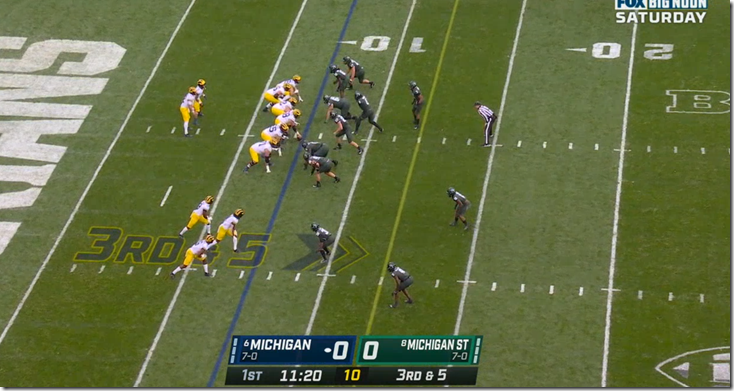
Even. Both tackles are at 3-tech, and both DEs are outside the tackles. MSU under Dantonio, and Northwestern under Fitzgerald do this a lot.
Odd. Aligned with a nose tackle directly over the center (0-tech) with two more DL lined up inside the tackles. Used for standard 3-4 and 5-2 formations, as in there are an Odd number of linemen.
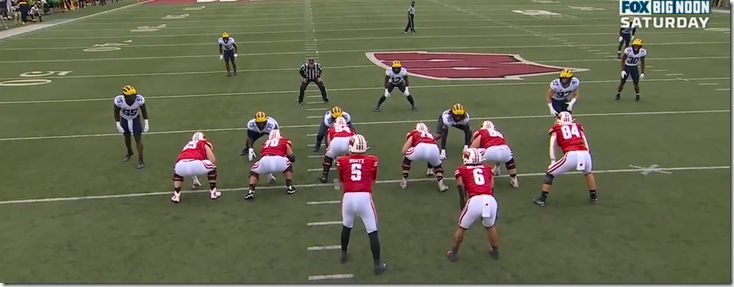
Okie. An Odd pass rush formation with lots of defenders up on the line of scrimmage to disguise which will blitz. Okie Zero, Okie 1, etc. refer to the number of DBs held back.
Over. The most common four-man front. With the nose tackle to the weak side of the center and a strongside DE covering the tight end. Sometimes I specify between Over and Over2, where the NT is lined up in a 2i tech (inside the guard) instead of a 1-tech (center's shoulder) but it's often so hard to tell I don't bother.
Racecar: Denotes Michigan's in their pass rush personnel (with a DE at DT). I will note where LBs are on the line by the gap, so this is Racecar B:
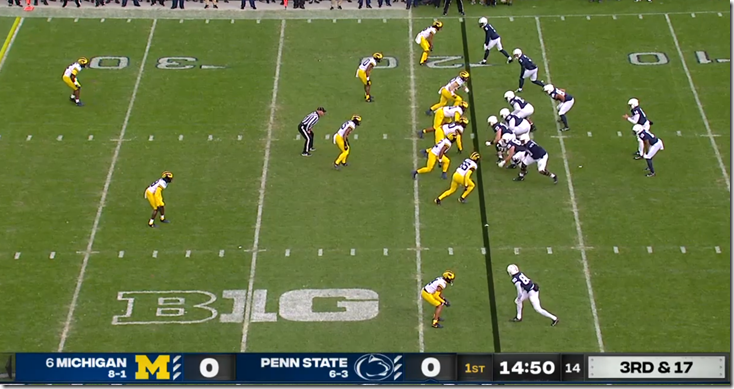
Split: An under front where the strongside DE is split out to a 9-tech. Michigan did this a lot last year with Hutchinson.
Splits: An over front where both DEs are split out to 9-techniques. Mostly used for pass-rushing.
Stack: The linebackers are aligned directly behind the linemen. Usually used in the 3-3-5.
Tite: Or "404" because the DL line up in 4-, zero, and 4-techs.
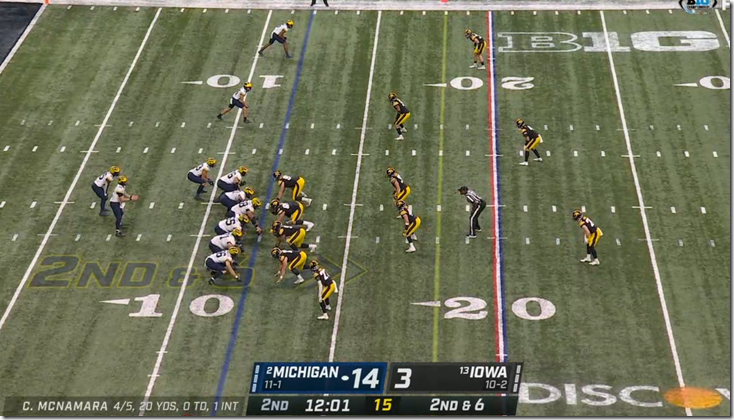
Under: The next most common 4-3 front, with the nose on the center's strongside shoulder and a 5-tech SDE inside the tight end, if there is one.
4i. When the DE who usually plays 5-tech is pulled in to a 4i-Tech.
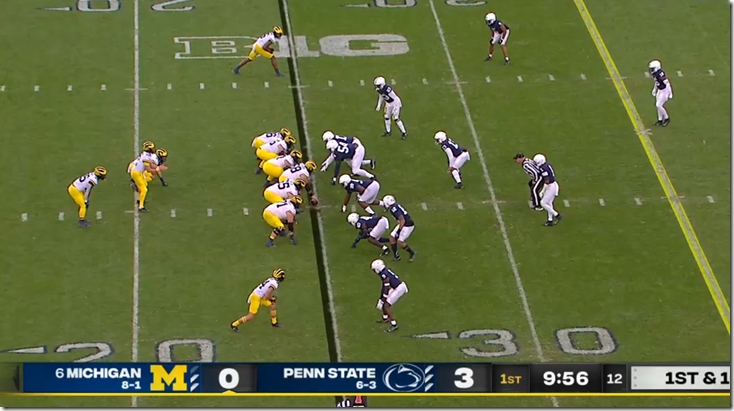
I'll be adding to this as we encounter more terms.
bookmarked.
1) Love the subtle reference to tricksy hobbitses.
2) I think pistol was left out - how does that differ from shotgun?
The "tech" terminology really bothers me... why is 2 the only one that gets an "i"?
Seems like it would be a lot easier to number the lineman from center out and then have it be "i" or "o" for inside or outside shoulder, or no letter for straight up.
So it'd go 1, 1l/r (left or right), 2i, 2, 2o, 3i, 3, 3o, 4i, 4, 4o.
Anyways... obviously not your terminology and was a great write-up/reference.
April 22nd, 2022 at 12:41 PM ^
There are multiple ways in doing this which makes it even more confusing. For example, the high school I coach at goes 0,shade,2i,2,3,4i,4,5,6,7,9. I believe the original dates back to Bear Bryant.
The original goes back to Fielding Yost, and his center Germany Schulz, who invented the linebacker position and shading off the opponent's shoulder, which was an adaptation to playing a man down on the defensive front. Today there's an argument between Vandy and Penn and a few other schools over who first wrote it down, but all of them were Yost disciples so it doesn't seem much of a mystery where they got it from.
This is dense, but awesome.
Gonna have to come back to this when I have much more time to review.
Thanks for the write up!
April 22nd, 2022 at 10:06 AM ^
This guide will be my Cyrano de Bergerac when I'm conversing with real-life knowledgeable football peeps.
April 22nd, 2022 at 10:46 AM ^
Indeed, football coaches you talk to will be like 'Dang, Billy Ray Valentine really nose his stuff!"
April 22nd, 2022 at 11:02 AM ^
I could pretend I didn't laugh. I did.
April 22nd, 2022 at 10:09 AM ^
That was indeed a lot of words. Thank you.
April 22nd, 2022 at 10:10 AM ^
Thanks for the great write-up, Seth - I'm also commenting to sticky this to refer back to!
One question I did have though:
What is the optimal grouping for ska bands deployed in an Ace formation? Is the drummer deployed directly behind the lead singer, or shaded to the backside, opposite the bass? Do you put the trombone or the tenor sax in the strongside flanker position?
April 22nd, 2022 at 10:49 AM ^
Does this mean the glossary is going to be revised?
https://mgoblog.com/content/mgoblog-glossary-terms-and-memes
Also, I thought Brian was the lemon-eater? Did Ace eat one too?
April 22nd, 2022 at 11:31 AM ^
Route terminology is always interesting. Did anyone else have different terms for their routes in Pee-wee, high school or any other level?
For me, the "corner" route was only called a corner route if a back or tight end ran it. If two receivers were running a smash concept, then the route from the slot receiver was called a "flag", after the flags that they used to have before foam pylons.
The zip route in this glossary was called a "pivot" or a "Wes Welker" if a white kid ran it. /s
Never will forget the old numbered route tree either. Needed something to put in our transparent wrist coaches.
April 22nd, 2022 at 12:07 PM ^
Interesting how terminologies can depend on who you’re talking to. I’ve always heard “Arc” referred to as “Bluff” outside of Mgoblog
April 22nd, 2022 at 12:16 PM ^
I beg to differ; it's a coach's worst conceit to bring their own gorram dictionary wherever they go. It defeats the purpose of language itself. Transitions are hard enough without having to learn a whole new vocabulary for the exact same concepts.
The hybrid space defender gets the worst of the lot. I'm not sure if two coaches in the country call it the same thing.
April 22nd, 2022 at 12:48 PM ^
In homage to, well, your avatar, if I ever get into coaching, I'll call the hybrid SS/LB player the Anaconda. My anaconda don't want none when they set the edge hun
Bluff is what Michigan calls it. Arc Read is how it's normally described in coaching clinics, and that terminology predated Michigan using it as a main weapon in 2018.
April 22nd, 2022 at 12:51 PM ^
Will this be on the test?
Yes.
Pass / fail?
Pass/incomplete
EXCELLENT! Bookmarked and shared. Thanks for putting this together!
Thanks. Nice refresher!
Seth, what do you call this one from Harbaugh's first season?

Not enough fullbacks.
April 23rd, 2022 at 11:39 PM ^
This is a very good reference, thanks. On the other hand, what is the best formation to counter Spider 2 Y Banana?
September 8th, 2022 at 9:00 AM ^
Simple. It's called Day-O Boat Slam Peel.
As in: when there are two spiders hiding in your bananas, sing "Day-O Banana Boat" while quickly eating one of the bananas and slam the peel into the trash.
Alternatively, call (that racist jack@$$) Gruden.
April 24th, 2022 at 10:02 AM ^
My head is spinning
October 4th, 2023 at 2:42 PM ^
Seth,
What are the column headings for all the charts?
Thanks
October 4th, 2023 at 5:19 PM ^
Added
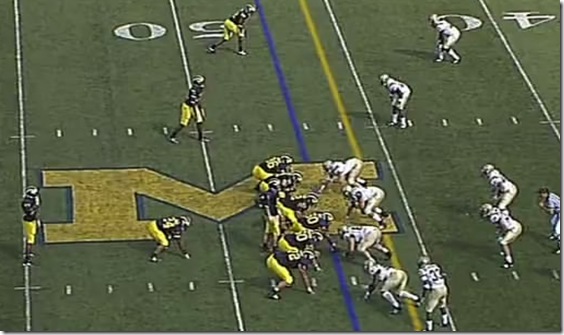

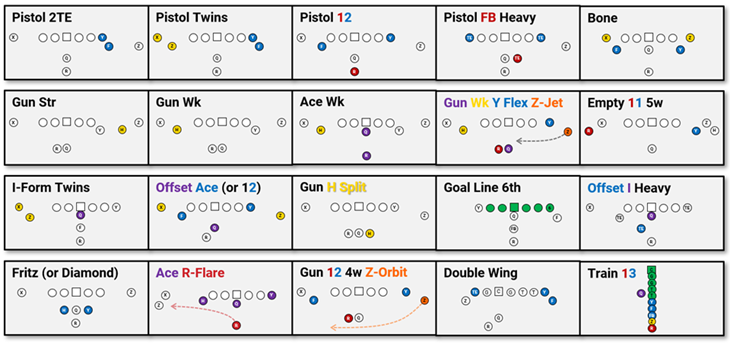
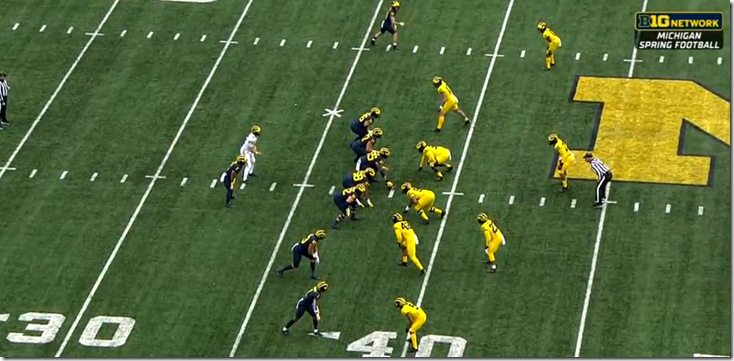
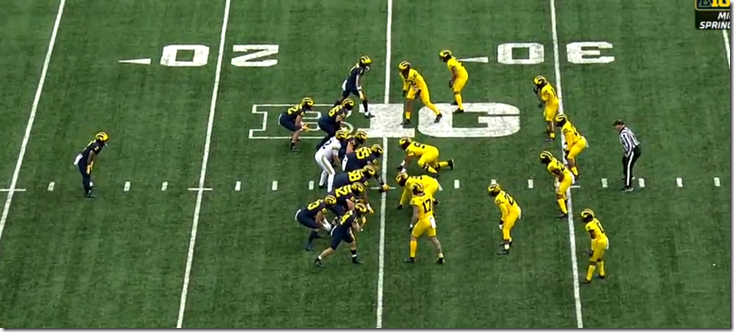


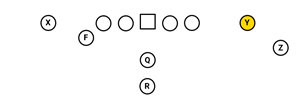
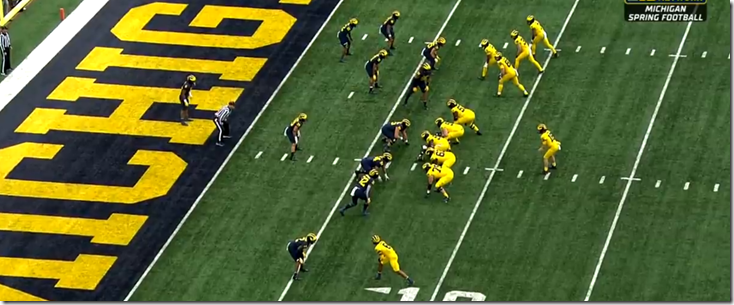

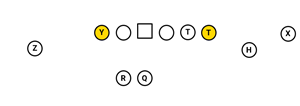


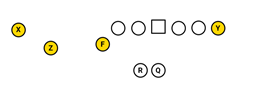



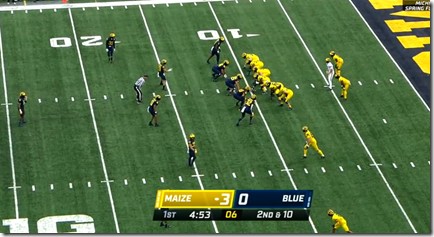


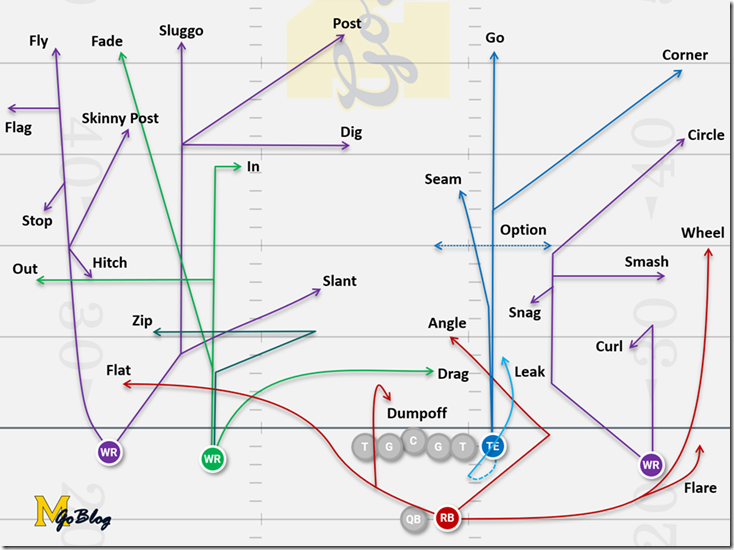



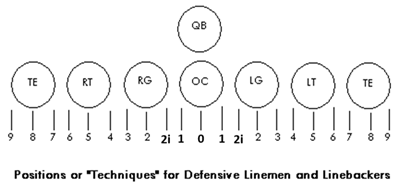
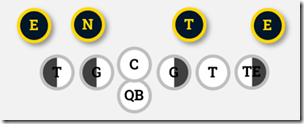

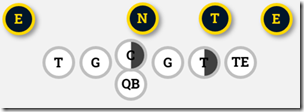
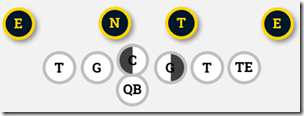
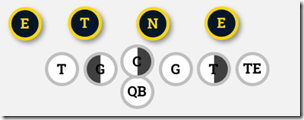
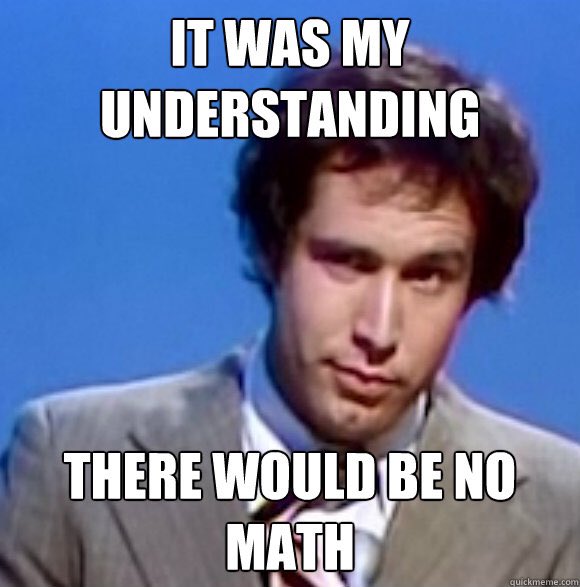
Comments